Egyptian Architecture – The Sphinx, the Pyramids, and More
Egyptian architecture is one of the most famous forms of ancient architecture. It is unlikely that someone will be unfamiliar with the great Egyptian monumental architecture found in the pyramids or the other great Egyptian monuments. Ancient Egyptian architecture is an immensely well-known form, but this article will look at a few of the things that may be less known. Pyramid buildings are famous, but what about the history and characteristics of other aspects of Egyptian architecture? Keep reading to find out a lot more.
Contents
- 1 A Look at Egyptian Architecture
- 2 The History of the Egyptian Civilization
- 2.1 The Predynastic Period (6000 – 3150 BCE)
- 2.2 The Early Dynastic Period (3150 – 2686 BCE)
- 2.3 The Old Kingdom Period (2686 – 2181 BCE)
- 2.4 The First Intermediate Period (2181 – 2055 BCE)
- 2.5 The Middle Kingdom Period (2134 – 1690 BCE)
- 2.6 The Second Intermediate Period (1674 – 1549 BCE)
- 2.7 The New Kingdom Period (1549 – 1069 BCE)
- 2.8 The Third Intermediate Period (1069 – 653 BCE)
- 2.9 The Late Period (653 – 332 BCE)
- 2.10 The Ptolemaic Period (332 – 30 BCE)
- 2.11 Later Periods
- 3 Examples of Egyptian Buildings
- 4 Frequently Asked Questions
A Look at Egyptian Architecture
Egyptian architecture tends to be associated with pyramids, and little attention is paid to many of the other pieces of architecture that this civilization produced over its 3000-year existence. Ancient Egypt went through many different periods that changed the way things were done as styles developed and changed. We have learnt much of what we know about Egyptian architecture through the religious monuments that have been left behind. Much of the early architecture of this ancient civilization was built using mud, and those mud brick structures washed away or were pulled down. We know as much as we can know.
So, let’s get started and have a look at some of what we know.
The Characteristics of Egyptian Architecture
Egyptian architecture is one of the oldest forms of architecture in the world. In addition, it was a revolutionary culture when it came to the development of monumental architecture, such as the creation of the pyramids. But just how did the Egyptians develop the structures that they did? Many of the most famous instances of Egyptian buildings, such as temples, palaces, and tombs, were often constructed using stone. They generally used limestone but also used sandstone and granite. However, these were the materials that were often used for far larger and more elaborate buildings. The vast majority of structures made use of mud bricks.
The use of mud bricks and stone formed the basis for the vast majority of Egyptian architecture.
These mud bricks were also generally sunbaked with mud collected from the banks of the Nile River. This mud was then placed into molds that were hardened in the sun before they were used. However, Egyptian architecture also made use of a few designs that would become far more prominent in later centuries. The arch was developed during the Fourth Dynasty, and it was used extensively in Egyptian monumental architecture. This was used alongside columns. Columns are typically associated with Ancient Greece but there were a variety of stone column varieties that were designed to incorporate more organic forms, such as bundled reeds.
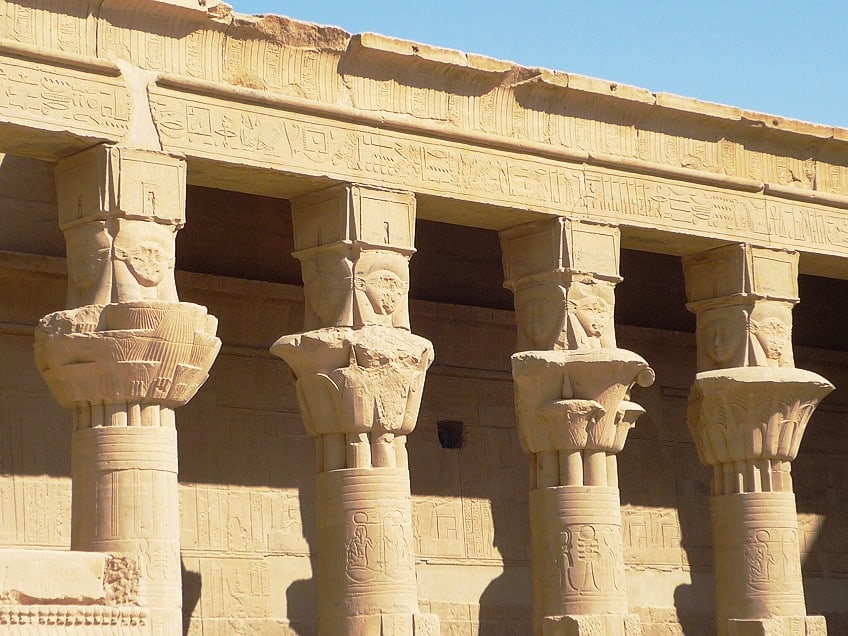
Another common characteristic of Egyptian architecture could be found in the development of garden structures. There were temples, and private, and vegetable gardens that blossomed during the Egyptian civilization. These gardens were often positioned close to the Nile River so that irrigation could be simplified, as irrigation was often done by hand in the earliest eras of the Egyptian civilization. Aside from these standard aspects of design, there was a prominent artistic flair to Egyptian architecture. This artistic dedication to the decoration of both the interior and exteriors of buildings is a famous aspect of Egyptian life. Pictorial representations of animals, deities, and other natural imagery were very common, and the use of hieroglyphic designs was also immensely prominent. Many of these pieces of art detailed the beliefs, history, and mythology of the Egyptian people.
These are only some of the primary characteristics of Egyptian architecture, and so from here, we will consider the history of the Egyptian people to see where their dedication to monumental architecture came from. Keep reading to learn more.
The History of the Egyptian Civilization
Ancient Egyptian history is a long and varied thing. So, let’s have a look at the history of Egypt and, by extension, some of the changes that were made to Egyptian architecture over the multiple millennia that Ancient Egypt existed.
The Predynastic Period (6000 – 3150 BCE)
The earliest days of the Ancient Egyptian civilization began about 8000 years ago, and back then, Egyptians were simply a collection of small tribes that had managed to figure out how to do agriculture and pastoralism. There was nothing particularly advanced about this culture, but then again, there was nothing particularly advanced about any culture at this time. These earliest Egyptian cultures developed some of the earliest ceramics, tools, and copper items.
Even in these early times, there were some instances of commerce across what would later be considered state lines.
Obsidian was imported from Ethiopia and there may have even been interaction with cultures from the Near East. Then, over the course of about a thousand years, this early culture was able to develop into a civilization that ran along the Nile River. This early culture, the Naqada civilization, was able to produce far more than the culture that had come before. They developed painted pottery, statues, vases, jewelry, and much more. This culture then started to record itself using a system that would eventually become one of the most recognizable aspects of Ancient Egypt: hieroglyphics.

The Early Dynastic Period (3150 – 2686 BCE)
Civilizations tend to start small but eventually develop themselves into an empire-oriented model with a monarch, and that was what happened during this period. A unified state began and the first of these Dynastic kings was able to seize power and control over the lower portions of Egypt. This also included the establishment of the capital city at Memphis which would allow for far greater control over agriculture, commerce, and labor.
These new kings became more and more powerful, and in death, they wished to be commemorated.
This was the beginning of monumental architecture in Egypt. The large mastaba tombs became a common form of Egyptian architecture for the burial of the monarchs. Through the power these kings wielded, they were able to develop and grow the Egyptian civilization into one of the greatest empires of the ancient world.
The Old Kingdom Period (2686 – 2181 BCE)
This period of time saw massive advancements in Egyptian architecture, technologies, and the arts. Some of the most famous pieces of Ancient Egypt architecture came from this period, such as the pyramids and the statue of the sphinx at Giza. These new monumental architectural forms were only some of the latest developments in Egyptian buildings, and more advancements would continue to develop. This period led to the beginnings of far more sophisticated irrigation methods, the increase of construction projects through conscription, the collection of taxes, and the creation of a justice system.

The central governance of this period of Ancient Egypt led to the growth of a whole new class of highly educated scribes and officials who could govern the increasingly centralized empire that had been developed. However, this would also eventually lead to the downfall of the pharaohs of the time. These new regional governors, who were known as nomarchs, started to challenge the leadership of the country. This, coupled with severe droughts, led to a lengthy period of turmoil that would follow for about 140 years.
The First Intermediate Period (2181 – 2055 BCE)
This period of the Ancient Egyptian civilization led to the destruction of the Old Kingdom in which various regional governors waged a variety of small-scale wars with one another over land. These newly independent states did not heed the pharaohs, and so the country was effectively split between two major factions. These factions would eventually battle against one another, and the northern Theban state would eventually come out on top and create a unified Egypt once again.
This led to a new period of prosperity in the country.
The Middle Kingdom Period (2134 – 1690 BCE)
Through the force of the Theban military, the new pharaohs were able to return the country to a far more stabilized state. During this time, there was a major renaissance of literary works, the arts, and monumental architecture. Egyptian monuments were seen as an important aspect of the culture of this new ruling class, and so Egyptian architecture developed at a stunning rate.
This new dynasty created new irrigation systems, structures, and mining operations, and grew the economy. However, these incredibly ambitious pushes, coupled with severe flooding, led to the decline in dynastic power. During this period, there were Canaanite settlers who became more prominent in the Delta region and would eventually seize power as the group known as the Hyksos.
The Second Intermediate Period (1674 – 1549 BCE)
It was time for yet another intermediate period. This time around, the Middle Kingdom, through its intense ambitions, was incapable of holding onto the power it once held. The Hyksos seized complete control over Egypt and built their own capital at Avaris. This new culture would integrate itself into Egyptian forms, such as through the maintenance of Egyptian customs. However, despite that, they forced the actual pharaohs into tribute payments through the threat of their military might. For instance, the Hyksos had newer technologies like chariots and composite bows that made them a difficult enemy.
However, their time would not last forever as war was eventually waged and they were completely defeated. Once the Hyksos were gone, a new dynasty would form.
The New Kingdom Period (1549 – 1069 BCE)
The time of the Hyksos had come to an end, and this New Kingdom period would usher in an era of immense prosperity as Egypt both secured its borders and developed diplomatic relations with the countries around it. Egypt entered into alliances with civilizations like the Canaanites and the Assyrians. However, this was also a time for expansion, and the Egyptian empire became bigger than it had ever been. This was also the time when Ramses the Great came to power and went on an architectural streak that is unparalleled.

Ancient Egypt architecture under Rameses the Great would lead to the construction of more temples, statues, and obelisks than ever before. In addition, he went on great military excursions. However, Egypt was becoming an increasingly wealthy country. This attracted the attention of many invaders, like the Libyan Berbers. Egypt was able to hold them off for some time but did start to lose much of their lands as their neighbors crushed them from the sides. These issues were exacerbated by internal tensions too as many of the high priests started to accumulate wealth and land rather than focus on the issues at hand. This would then lead to yet another crisis.
The Third Intermediate Period (1069 – 653 BCE)
The third period of intermediate turmoil came after the death of Rameses XI. The new ruler was not able to attain the loyalty of the high priests, and this led to a splintering when the Libyan Berbers continued their assault. They claimed large portions of the country and threatened the existing dynasty through the creation of their own. The prestige of the Egyptian civilization had started to decline once again and there was eventually a war against the Assyrians. While the Egyptians did manage to push them back for some time, they were ultimately incapable of succeeding against this stronger force.
The Assyrians eventually pushed them back, occupied Memphis, and even sacked the temples.
The Late Period (653 – 332 BCE)
With Assyrian control over the country, the foreign rulers placed vassals in charge of this newly defeated Egyptian civilization. These vassals were eventually forced out by Psamtik I with the help of Greek mercenaries. However, that victory did not stop Persian invaders from eventually taking much of the country.
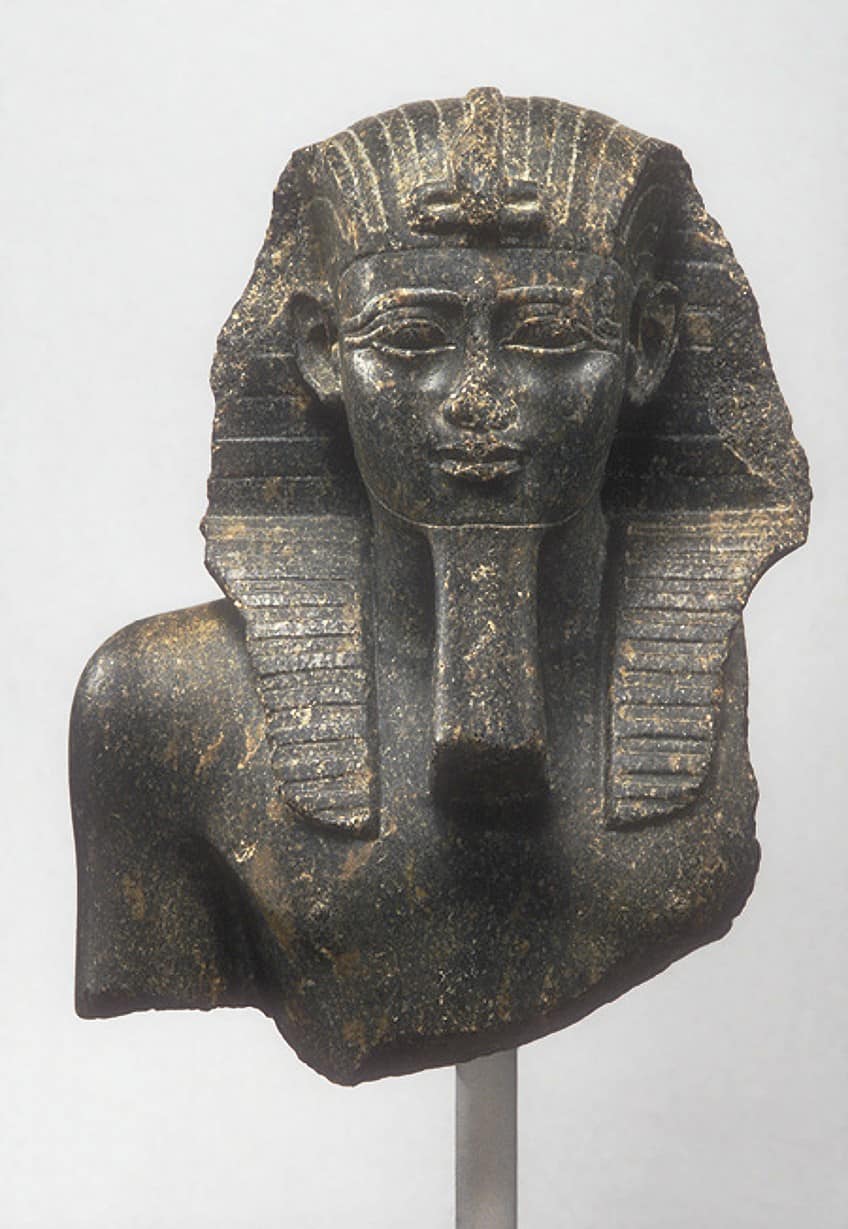
This then led to something of a back-and-forth as the Egyptians regained independence before being overthrown by the Persians again until it all ultimately came to an end. Alexander the Great would stop all the conflict when he marched into the country and the Persian ruler decided to give Egypt to him rather than fight the famed military commander for it.
The Ptolemaic Period (332 – 30 BCE)
The Egyptians welcomed Alexander the Great with open arms, and under him, the Macedonian Ptolemaic Kingdom was formed. This kingdom was quite benign in its rule as it adopted many Egyptian models, established a new capital at Alexandria, and turned the region into one of the most important sites for education in the world.
For instance, the Library of Alexandria was located in Egypt under this Ancient Greek rule.
There were still tensions, and there would ultimately be conflicts between the ruling Greeks and the Egyptians, but they would remain mostly under control. This Ptolemaic Kingdom would remain in place until the region was finally conquered by the Romans. This would ultimately end the Ancient Egyptian era.
Later Periods
Once Greek control over Egypt came to an end, there were a variety of other rules. The Romans were the conquerors of much of the Old World, and they controlled the country for many centuries until the true beginnings of Islamic rule. This would eventually culminate in the Ottoman Empire’s control over the region until the 19th century. The country would then ultimately fall to the British and would remain a colony of the British Empire until after the Second World War. Only after that, did Egypt gain its independence for the first time in several thousand years.
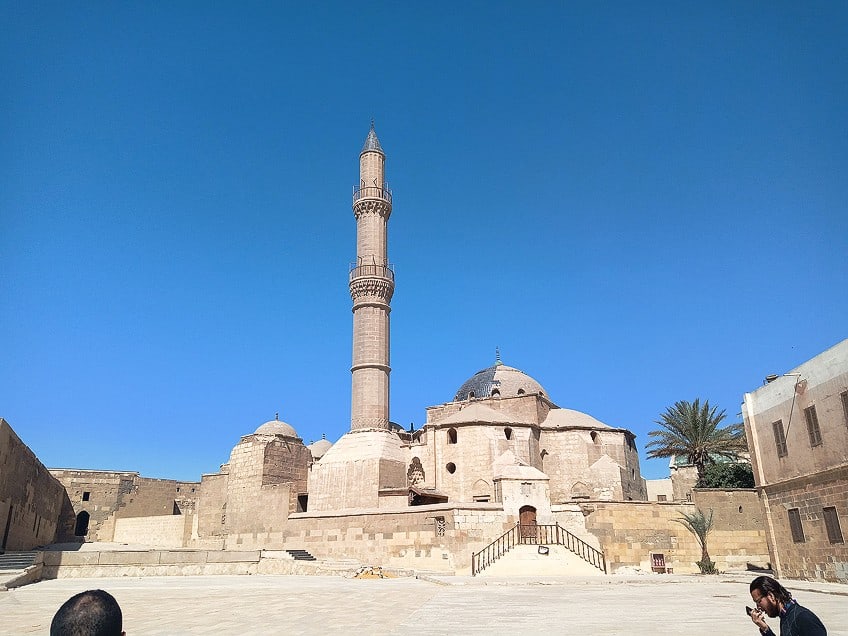
In more recent decades, the influence of Ancient Egyptian architecture would go on to influence various groups around the world. The discovery of the tomb of Tutankhamun would massively impact the way the world saw Ancient Egypt and would lead to a fervor about Egyptian culture and architecture. So, while the new Egyptian Revival styles of architecture that developed were not necessarily related to actual Ancient Egypt architecture, they did form part of a desirable aesthetic. This form of Egyptian Revival architecture is still in use to this day.
Examples of Egyptian Buildings
Ancient Egypt architecture spans an immensely long period of time, and there are many examples of Egyptian monuments, temples, pyramids, buildings of other descriptions, and other tombs developed during this period. Egyptian architecture tends to be remembered for its pyramid buildings by many people, but a lot more was constructed during the various eras of this ancient civilization.
So, let’s have a look at some of those Egyptian buildings in question.
Pyramid of Djoser (2670 – 2650 BCE) in Saqqara
| Architect | Imhotep (Late 27th century BCE) |
| Date Constructed | 2670 – 2650 BCE |
| Function | Burial structure |
| Location | Saqqara, Egypt |
The Pyramid of Djoser is the first pyramid that was constructed by the Ancient Egyptians. Before the construction of this particular pyramid, Egyptian pharaohs were generally buried in structures called mastabas. These are flat funerary monuments that, while impressive, would never go on to achieve the fame of the pyramids. This particular pyramid was constructed for a pharaoh of the Third Dynasty, Djoser. This pyramid was also a step pyramid, so it was not quite like the true pyramids that would come later, like the famous Great Pyramid of Giza. Instead, this pyramid was comprised of several large steps that rose up to an original height of 62.5 m (or 205 ft). It was then later covered in white limestone, as was common in any other pyramids.
The entire complex around which the pyramid is constructed includes a temple, a deep trench, an entrance comprised of a colonnade, an enclosed wall, and several pavilions. The entire complex is obviously not as impressive or archaeologically important as the pyramid itself though.
This early pyramid was the first real shift away from mud bricks and towards limestone, which is significantly sturdier as a building material. This allowed the six large steps to rise up above the ground and provide all onlookers with a sight of this grand tomb. There are many different interpretations from various Egyptologists about just why these early Egyptian architects decided to shift away from the more common mastaba style and towards this wholly new form, but whatever the reason, it has become the most recognizable piece of Egyptian architecture. This burial site for Pharaoh Djoser is located in the Saqqara necropolis that lies northwest of the ancient Egyptian city of Memphis.
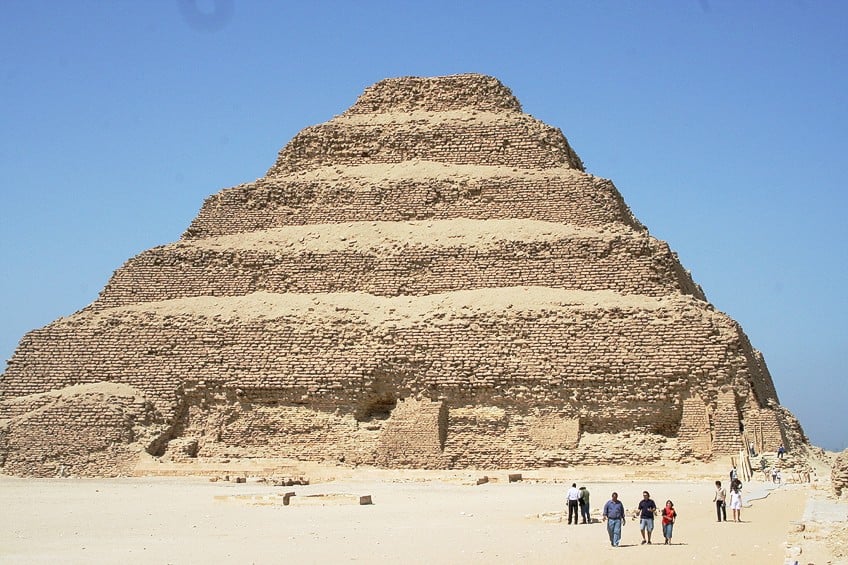
Perhaps one of the reasons for his far grander tomb was that he ruled for a relatively long time in terms of ancient rulership, and he even lived long enough to actually plan out his own pyramid. It’s an innovative structure that led later Egyptian builders and architects to be astounded by what they saw. This structure also would have required significant levels of labor power, the likes of which had never been adopted before. However, the power he had managed to accrue helped to ensure this was not too difficult. So, this Egyptian monument to an ancient king still stands to this day and is open to visitors.
Great Pyramid (26th Century BCE) in Giza
| Architect | Hemiunu (Around 2570 BC) |
| Date Constructed | 26th century BCE |
| Function | Burial structure |
| Location | Giza, Egypt |
The Great Pyramid of Giza is, obviously, the most famous Egyptian building in the world. It has been known for thousands of years and was even written about in the work of Herodotus, the father of history in The Histories. This pyramid building was so important and magnificent for all to behold that it became one of the Seven Wonders of the Ancient World. Then because the structure refused to collapse like every other Wonder of the Ancient World, it survived until the New Seven Wonders of the World were announced. It is not considered to be one of those, but it does still have an honorary title.
There had been a long-running belief, which originated from the Ancient Greeks, that slave labor was the most readily used form of labor for this kind of structure, but modern discoveries have disputed that.
It is possible that rather than slaves, the pyramids at Giza instead made use of conscripted laborers. Either way, the construction of a building such as this required an extensive array of laborers who worked at it for decades. It actually took about 27 years to construct, and it was constructed for the pharaoh of the Fourth Dynasty, Khufu. This is not the only pyramid at Giza, but it is the most magnificent one at 146.6 m (or 481 ft). This actually made the Great Pyramid the tallest structure in the world for nearly 4000 years. Even then, the next largest structures in the world were not examples of the same kind of monumental architecture. They were tall, but they were not wide like the Great Pyramid.
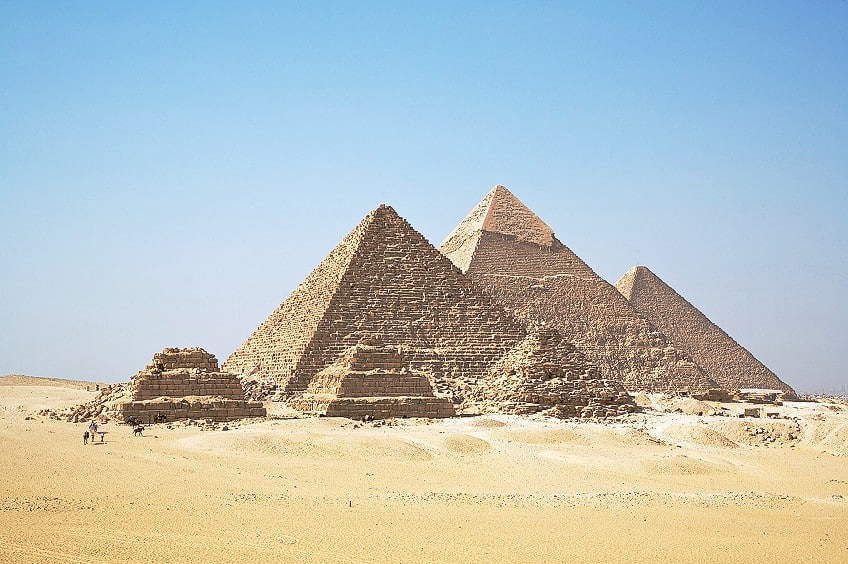
In addition, they were not constructed of millions of tons of limestone, hundreds of thousands of tons of mortar, and thousands of tons of granite. The Great Pyramid was a structure that was without parallel for thousands of years. The roughly 2.3 million blocks that went into the construction of this pyramid building allowed the structure to house the royal chambers within its sloped walls. There were locations inside for the King and Queen’s Chambers, and the entire complex is complete with two temples, a few tombs for other family members, and a few smaller pyramids for the other wives of Khufu.
The Great Pyramid itself may have been for the pharaoh, but the surrounding area was permitted to be for those who were less powerful than the grand monarch who ordered the construction of it all.
The Great Pyramid at Giza and its associated structures and additional pyramids are some of the most famous sights in the entirety of Egypt. They have withstood the ages to become iconic emblems of Egypt itself, and they are visited to this day. These structures have become, by far, the greatest pieces of Egyptian architecture that would go on to inspire the works of many others. The great works of the Fourth Dynasty were, in many ways, never supplanted by the next several generations, but these pyramids have remained through it all.
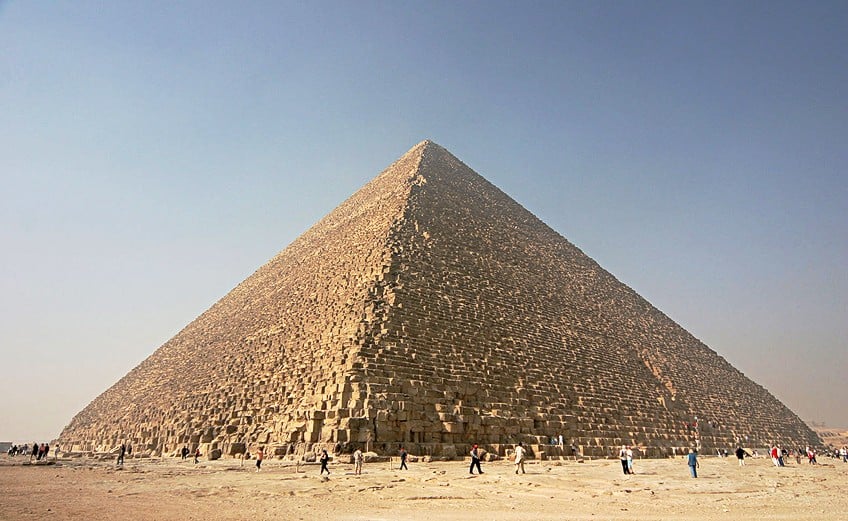
Great Sphinx (Around 2500 BCE) in Giza
| Architect | Possibly Djedefre (26th Century BCE) |
| Date Constructed | Around 2500 BCE |
| Function | Statue |
| Location | Giza, Egypt |
The Great Sphinx of Giza is not technically a building in the traditional sense of the word. It doesn’t have an interior for you to visit or a roof structure, but regardless of that, it is a piece of Egyptian architecture that deserves to be mentioned. After the Great Pyramid, and pyramid buildings in general, the Great Sphinx is probably the most iconic piece of Egyptian architecture. This ancient Egyptian monument with its broken nose is one of the most recognizable architectural marvels of the ancient world. The Sphinx also happens to be the oldest known monumental structure that has been found in Egypt, and it is located in the same complex as the Great Pyramid of Giza. So, it clearly does have some illustrious company around it.
However, it was not constructed under the rule of the same pharaoh as the Great Pyramid and was instead constructed under Khafre, but, to be fair, Khafre was also one of the sons of the pharaoh who was buried in the Great Pyramid.
This ancient Egyptian monument is constructed out of limestone, and it depicts a reclining sphinx. The sphinx is a mythological creature that acts as a hybrid of both human and lion features. It is somewhat different to the Ancient Greek version of the same creature, but there are some parallels worth exploring for those who are interested. Either way, this particular sphinx statue faces the east and stands on the west bank of the Nile. It guards what resides behind it and it does so with the face of the pharaoh, or at least this appears to be the case. The entire statue is 73 m (or 240 ft) long when measuring from the front paws to the tail, and it is 20 m (or 66 ft) at its tallest. and 19 m (or 62 ft) at its widest. It was cut from the bedrock of the area and some of the stones that were cut around this statue were then used for the temple that is right in front of it, although that temple was either never finished or simply left unenclosed. We do not know for sure.

One of the most recognizable features of the Sphinx at Giza is that it is missing its nose. We do not know the exact reasons for the statue lacking a nose, but there were many theories over the years. There were views that it was destroyed by a cannonball belonging to the army of Napoleon Bonaparte during his campaign in Egypt. However, the nose was missing long before that date. In addition, there are far older records that claim it was destroyed on purpose. It wasn’t until much later, in the 20th century, that an archaeologist was able to determine that chisels of some sort had been hammered into the nose. This means that it was some kind of act of vandalism that could have occurred any time between the 3rd and 10th centuries CE.
Regardless of who cut off the nose, and regardless of the nose’s missing status at all, the Sphinx at Giza stands as one of the quintessential instances of Egyptian monumental architecture and one of the most important Egyptian monuments in general. It may have been damaged, but that damage has become part of the imagery of the site.
Temple of Karnak (20th Century BCE) near Luxor
| Architect | Various |
| Date Constructed | 20th century BCE |
| Function | Temple complex |
| Location | Near Luxor, Egypt |
The Temple of Karnak is a large temple complex that is partly surrounded by a modern village called El-Karnak. This ancient temple complex, which many have taken to simply calling Karnak, is one of the most important archaeological sites in Egypt. The site contains a variety of temples, chapels, and other structures. Karnak started its development during the Middle Kingdom period under Pharaoh Senusret I. However, it was not a complex that was finished during his reign between 1971 and 1926 BCE, because it continued to be under construction for nearly 2000 years. It was still being constructed, in some shape or form, during the Ptolemaic Kingdom, which would see the end of Ancient Egypt in 30 BCE.
Karnak was located within the bounds of Thebes, the immensely important city of Ancient Egypt, and it was constructed in an area known as Ipet-isut.
This translates to “The Most Selected of Places,” and so it was clearly an important place. It was specifically the primary place of worship during the 18th Dynasty. One of the primary factors inherent in this structure is just how long it was constructed. It is a massive complex that was constructed during the reign of about 30 different pharaohs over the ages. This has led Karnak to becoming the most diverse and complex series of structures in the entirety of Ancient Egypt. There are numerous instances of utterly unique Egyptian architecture throughout the temple complex.
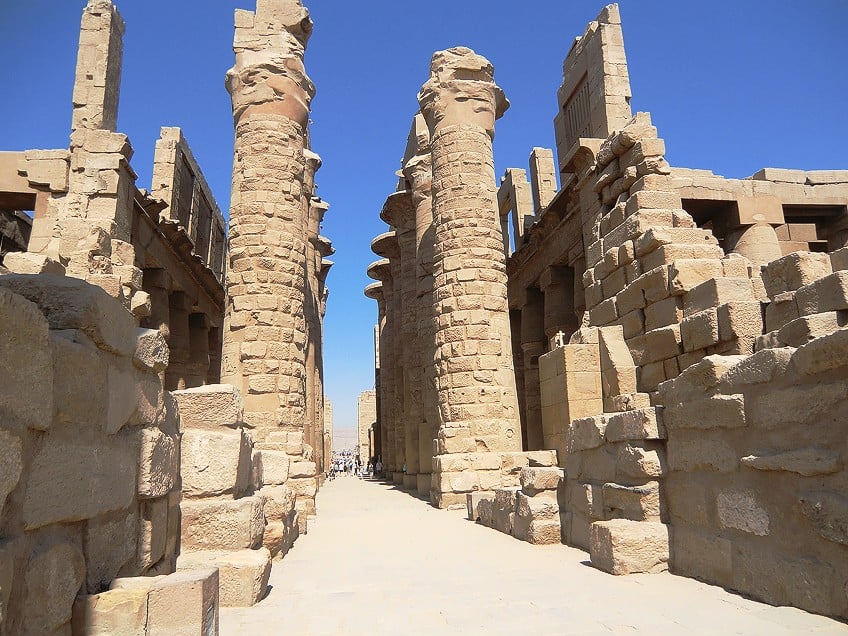
Some of the most famous pieces of monumental architecture within Karnak include the many representations of Egyptian deities that adorn the many structures of Karnak. This is in addition to the Great Hypostyle Hall, which is a staggeringly massive Egyptian building comprised of 134 columns arranged in 16 rows. These columns are comprised of differing sizes, but they are all massive. Getting structures of that size into this site would have been a monumental task on its own, but the Ancient Egyptian builders managed to succeed in that regard. Some of the sandstone used in some of the temples also came from about 161 km (or 100 miles) away. This was an immense undertaking that continues to baffle many. However, the temple complex as a whole has seen many instances of pieces being removed to be used elsewhere, but this is quite common for many ancient structures.
The entire complex is now also open to the public. It does not receive as many visitors as the Great Pyramid, but a regular person can visit many of the sites within this temple complex. However, some places, like the Precinct of Montu are not open to the public. So, you can visit it, but you can’t visit all of it.
Valley of the Kings (16th – 11th Centuries BCE) in the Theban Necropolis
| Architect | Various |
| Date Constructed | 16th – 11th centuries BCE |
| Function | Tomb structures |
| Location | Theban Necropolis, Egypt |
The Valley of the Kings is less a single structure and more a valley that contains a vast array of Egyptian buildings. These buildings are actually tombs, and they are non-pyramid tombs too. Not every pharaoh got to have a pyramid. If that were the case, there would be far more of them in the country. Instead, many of them were buried in the Valley of Kings. This vast burial valley contains 63 tombs, but those tombs range in complexity. One of them, the most complex one of the lot, has 120 chambers within its walls. So, they may not have been as illustrious as the pyramids that became so famous around Egypt, but they were still large structures full of decorative elements taken from Egyptian mythology that have helped us understand the Ancient Egyptian culture along with its beliefs and funerary practices.
Sadly, practically every single one of these tombs was robbed in antiquity. So, this wasn’t modern treasure hunters seeking a quick buck.
These ancient robbers were enticed by the idea of the immense wealth of the pharaohs that were buried with them. It is a rather enticing payday, after all. So, the Valley of Kings contained many of these tombs, and it was used over a period of nearly 500 years between the 16th and 11th centuries BCE. These rock-cut tombs were later excavated to learn as much as possible about those who had been buried. These tombs have held immense archaeological interest ever since the end of the 18th century. However, it was the discovery of one particular tomb in the Valley of Kings that really sent ripples around the world.

The 1922 discovery of the Tomb of Tutankhamun, the child pharaoh, and his famous death mask have become mainstays in the popular culture surrounding Ancient Egypt. In fact, the stories of the curse of the mummy, which originate from the uncovering of the immensely well-preserved body of Tutankhamun, inspired the classic horror film, and its many sequels and reboots, The Mummy. The Valley of Kings is not only an important archaeological site but also the source of a pop cultural icon in the modern day. The Valley of Kings remains, to this day, a major spot for tourist activity as well as remaining an important archaeological site. The many tombs have taught us much about Ancient Egyptian culture, and there is likely still even more to learn.
We have thus come to the end of our discussion about Egyptian architecture. We have examined the characteristics, history, and a few examples of Egyptian architecture as a whole, like pyramids, buildings of other kinds, and temples. Hopefully, you’ve come out of this knowing a lot more than when you first started. All that’s left to say is that we hope you have a great day/week/month ahead, and that you always keep learning!
Frequently Asked Questions
When Was the Ancient Egyptian Period?
Ancient Egyptian history is a lengthy period of time that lasted several thousand years. Egyptian history moved through several major periods, but the earliest origins of Egyptian culture go as far back as 6000 BCE during the Predynastic period. This would lead to several dynasties over thousands of years that eventually culminated in the last of the Egyptian dynasties, the Ptolemaic Dynasty. This final dynasty ended in 30 BCE. With the end of the Ptolemaic Dynasty, the time of Ancient Egypt had come to an end.
What Are the Characteristics of Egyptian Architecture?
Ancient Egypt architecture has a distinct and monumental flair to it. Some of the most common materials used by the Ancient Egyptians included mud bricks, limestone, sandstone, and granite. The structures built from these materials were often elaborately decorated and made use of columns with sophisticated capital structures. In addition, there was a strong emphasis on various varieties of gardens within Egyptian architecture.
What Are Pyramids Used For?
Pyramids are a form of monumental architecture that is designed around a triangular design. The pyramid buildings were intended as a form of burial structure for the Egyptian pharaohs. They were not actually the most common form of burial structure for the pharaohs, but they have become the most famous examples of Egyptian buildings and are now seen as emblematic of the culture and country as a whole.
What Is Monumental Architecture?
Monumental architecture is essentially exactly what it sounds like. It is the construction of massive structures that would serve as monuments of some description. This form of architecture is fundamentally massive in size and is meant to reflect the importance of whatever it is that’s being built. The pyramids in Egypt are a very good example of Egyptian monuments in the monumental architecture tradition.
What Is Egyptian Revival Architecture?
Egyptian architecture has been around for a long time, and so there was always bound to be a resurgence of the form. Egyptian Revival architecture, which is an attempt to emulate Egyptian architecture in more modern surroundings, it is a modern revival of Ancient Egypt architecture. This form would make use of the kinds of typical designs, decorations, and hieroglyphic aspects that were prominently used in actual Ancient Egyptian architecture. However, this Revival form was purely for aesthetics and never carried the same kind of cultural weight that the original forms carried.
Justin van Huyssteen is a writer, academic, and educator from Cape Town, South Africa. He holds a master’s degree in Theory of Literature. His primary focus in this field is the analysis of artistic objects through a number of theoretical lenses. His predominant theoretical areas of interest include narratology and critical theory in general, with a particular focus on animal studies. Other than academia, he is a novelist, game reviewer, and freelance writer. Justin’s preferred architectural movements include the more modern and postmodern types of architecture, such as Bauhaus, Art Nouveau, Art Deco, Brutalist, and Futurist varieties like sustainable architecture. Justin is working for artfilemagazine as an author and content writer since 2022. He is responsible for all blog posts about architecture.
Learn more about Justin van Huyssteen and about us.
Cite this Article
Justin, van Huyssteen, “Egyptian Architecture – The Sphinx, the Pyramids, and More.” artfilemagazine – Your Online Art Source. October 19, 2023. URL: https://artfilemagazine.com/egyptian-architecture/
van Huyssteen, J. (2023, 19 October). Egyptian Architecture – The Sphinx, the Pyramids, and More. artfilemagazine – Your Online Art Source. https://artfilemagazine.com/egyptian-architecture/
van Huyssteen, Justin. “Egyptian Architecture – The Sphinx, the Pyramids, and More.” artfilemagazine – Your Online Art Source, October 19, 2023. https://artfilemagazine.com/egyptian-architecture/.



